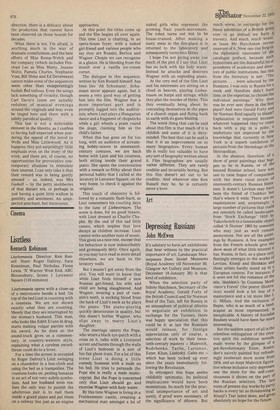Art
Depressing Russians
John McEwen
It's salutary to have art exhibitions that bear witness to the practical importance of art. Landscape Masterpieces from Soviet Museums (Royal Academy till November 30, Glasgow Art Gallery and Museum, December 18-January 28) is that kind of exhibition.
When the selection party of Sidney Hutchison, Secretary of the Royal Academy, Gerald Forty of the British Council and Sir Norman Reid of the Tate, left for Russia in an atmosphere of political détente to negotiate an exhibition in exchange for the Turners, there was happy speculation that this could be it: at last the Russians would release, for foreign appreciation only of course, a selection of work by their twentieth-century masters — Malevich, Rodchenko, Tatlin, Larionov, Exter, Kliun, Lissitzky, Gabo etc — which has been locked up ever since the years immediately following the Revolution.
In retrospect this hope seems childishly optimistic. Its political implications would have been momentous. So much for the practical unimportance of art and surely, if proof were necessary, of the significance of détente. But
much worse, in exchange for the finest exhibition of a British artist ever to go abroad we have a travesty. And much, much worse, at least Mr Hutchison seems unaware of it. Now one can forgive the diplomatic courtesies of the catalogue preface, because such hypocrisies are the distasteful lot of presidents of academies and directors of public institutions, but this from the Secretary is not: "The pictures . . . were selected by the Russians. I was only in Russia for a week and therefore didn't have time, or the expertise, to choose the individual paintings." Why then was he ever sent there in the first place? And were Gerald Forty and Sir Norman Reid equally to blame? Explanation is required because whatever happened they've come back with a pig in a poke, a misfortune not improved by the knowledge that currently in New York is a superb exhibition of pictures from the Hermftage at the Metropolitan. In the absence, therefore, of a show of great paintings that happen to be in Russia, or of the banned Russian school, here was one to raise hopes of comparison with the more rural strain of nineteenth-century Russian literature. It doesn't. Levitan may have been the friend of Ghekhov but that's where it ends. There are nn masterpieces and, surprisingly, a large number of pictures that could not remotely be called landscapes from 'Stock Exchange' 1810 bY Yakovlevich to a lamentable object called 'A Shower' 1963 by someone who may just as well remain anonymous. Nor are all the paintings by Russians. A few examples from the French schools give the show most of what little interest It has. Russia, in fact, as a place only fleetingly emerges in the works of Levitan, Kiunji and Shishkin and these artists hardly stand up in a European context. For instance, If it were not for the romance of the title, Shishkin's 'In Countess Mordvinov"s Forest' (the poster illustration) would look a lot less of 3 masterpiece and a lot more like J. G. Millais, And the exclusion of Repin, who is as much of a landscapist as most represented, is inexplicable. A history of Socialist Realism would have been far more interesting. But the saddest aspect of all is the relentless subjugation of the creative spirit the exhibition reveals, made worse by the glimpse of a pre-Revolutionary Exter, Kustodier's naively painted but refreshingly exuberant snow scene from 1916, and an inept Malevich figurative whose inclusion only depresses one the more for the self-consciousness it shows on the part of the Russian selectors. The last room of present day works by partY hacks is every bit as threatening as Kiunji's Tsar laden skies, and gives absolutely no hope for the future.
































 Previous page
Previous page